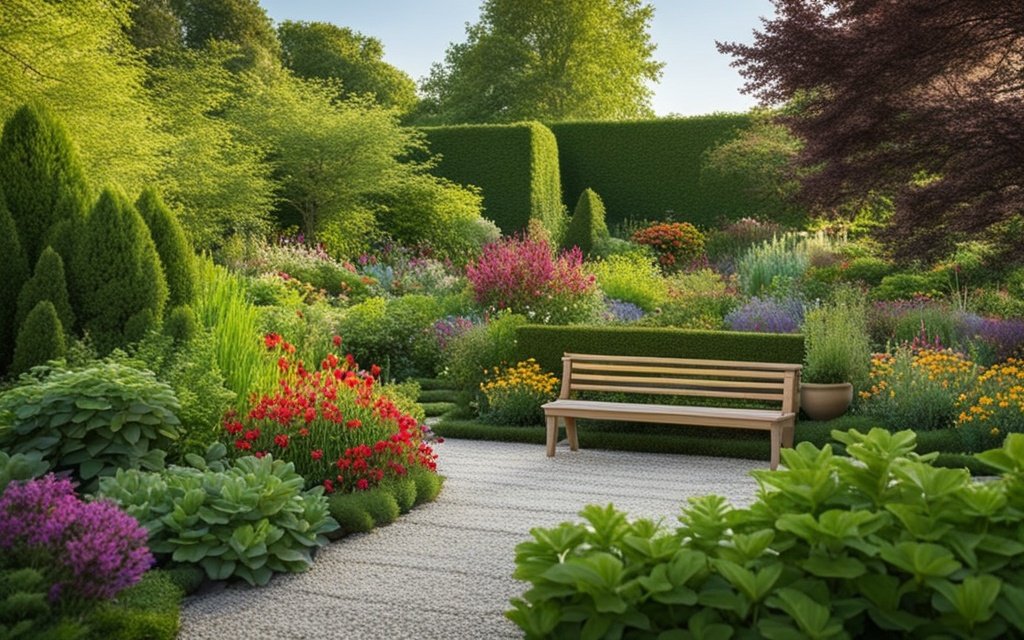Imagine soil running through your fingers, smelling fresh flowers, and hearing leaves rustle. This isn’t just a hobby for some; it’s a form of healing. Therapeutic horticulture combines plant science and healing methods.
Therapeutic horticulture has ancient origins and has changed lives throughout history. In the 19th century, Dr. Benjamin Rush saw its mental health benefits. Today, places like the Cape Fear Botanical Garden offer it to groups including the Vision Resource Center and the Wounded Warrior Project. It shows its wide healing reach, not just for mental health.
At the Cape Fear Botanical Garden, veterans enjoy “Vets in the Garden Day”. It helps them find peace in nature. The project is part of their work with the USO of North Carolina. This work shows the power of therapeutic horticulture in helping military families.
Practicing therapeutic horticulture needs careful planning. Professionals certified by the American Horticulture Therapy Association (AHTA) lead it. Everything from the therapy itself to the garden design is thought out. It helps individuals find physical healing, mental strength, and a sense of community.
Key Takeaways
- Therapeutic horticulture mixes plant science with health benefits.
- Its history goes back to ancient times and figures like Dr. Benjamin Rush.
- Places like Cape Fear Botanical Garden have various programs for the community.
- Events like “Vets in the Garden Day” show its impact on veterans.
- The AHTA ensures that therapeutic practices meet certain standards.
Understanding Therapeutic Horticulture
Therapeutic Horticulture is a valuable practice where gardening helps improve health. It aids in physical, cognitive, and emotional well-being through horticultural therapy. This therapy helps people learn or regain skills such as memory and cognitive abilities.
It started in the 1940s and 1950s, helping hospitalized war veterans. Over time, horticultural therapy grew to help more than mental illness. It’s now used in various settings such as rehab centers and community programs.
Interest in therapeutic gardens is growing. These gardens are designed specifically for healing in healthcare settings. They come in types like healing, enabling, and restorative gardens, each with a unique purpose.
Horticultural therapists are key to the success of therapeutic horticulture. They usually have a degree related to this field. The American Horticultural Therapy Association (AHTA) was formed in 1973, highlighting the need for trained professionals.
The AHTA offers a special credential for these therapists. To earn it, they must finish a 480-hour internship. This training helps them aid in physical rehab, improving muscle strength and balance.
Therapeutic horticulture sessions last about 45-60 minutes. Activities include garden care and starting plants from seed. Practitioners also make therapeutic gardens, lead nature activities, offer adaptive tools, and track progress. They work with other experts to give complete care.<//http>
Benefits of Therapeutic Horticulture
Therapeutic horticulture is a great way to improve health and well-being. It helps in physical healing and learning new skills. This type of therapy impacts people in a comprehensive way.
Physical and Cognitive Health
Gardening as therapy boosts physical health. It helps build muscles, balance better, and have more stamina. For those healing from injuries or strokes, it’s especially helpful. It also sharpens the mind.
Scientific studies show therapeutic gardens meet physical and sensory needs. They are key in helping people recover.
Mental and Emotional Wellbeing
Gardening is great for calming the mind and sparking the senses. It plays a big role in improving mental and emotional health. For older people in care, it boosts their overall well-being.
It also boosts confidence, self-worth, and discipline. Plus, it supports brain health by helping with memory and reducing stress. This elevates one’s mental state.
Social and Vocational Skills
Therapeutic horticulture is a way to better social and work skills. Gardening teaches important communication and teamwork abilities. It also gives expertise for work, making individuals more self-reliant.
Research points out its positive effects on mood and heart health. It complements other mental health treatments well. Spending time in nature sparks curiosity and hope for the future. This shows the all-around advantages of therapeutic horticulture.
Therapeutic Horticulture: What It Is and How to Practice It
Therapeutic horticulture uses plants to improve body and mind health. It involves learning how to use garden activities as therapy. Knowing the right techniques and how to design therapeutic gardens is key.
Essential Techniques
Working with plants is at the heart of therapeutic horticulture. This includes tasks like gardening, planting seeds, and crafting with plants. Sessions usually last from 45 to 60 minutes and focus on building skills, cognitive development, and adapting the space for everyone’s needs.
To become a therapeutic horticulturist, you need proper education and training. The American Horticultural Therapy Association (AHTA) says you need a bachelor’s degree related to horticultural therapy. You also need specific courses and a 480-hour internship. The AHTA sets these requirements to make sure therapists can lead successful sessions.
Garden Design Considerations
Designing therapeutic gardens is vital for effective therapy. These gardens need things like easy-to-enter doors, walkways, raised beds, pots, and plants that appeal to the senses. The AHTA made guidelines in 1995 to help create gardens that meet the needs of various people, making sure the gardens help them connect with plants.
When designing these gardens, it’s important to think about what everyone needs. The aim is to make gardens that bring the most therapeutic benefits, no matter if it’s in a hospital or someone’s backyard.
| Tuition Option | Cost |
|---|---|
| Regular Tuition | $359 |
| Early Bird Discount | $349 |
| Members Discount | $349 |
| Volunteers Discount | $329 |
| University Professionals Discount | $329 |
| Payment Plan | $200 initial + $159 balance |
Therapeutic Horticulture in Different Settings
Therapeutic horticulture takes place in many areas, aiming to improve well-being. Clinical spots, community areas, and specialized programs use plant activities. These help people feel better overall.
Clinical Settings
Medical hospitals and rehab centers practice clinical horticultural therapy. Here, plant activities help those with disabilities or health issues recover. These settings focus on plant-care activities.
Working with plants can boost memory, social skills, and cognition. Patients caring for plants feel more purposeful and valued.
Community Environments
Programs in community areas like shelters and public gardens use plants for therapy. These activities increase life quality and help people connect. They bring a sense of community and improve well-being.
Specialized Programs
Programs designed for specific groups meet various needs. Schools and veteran centers use therapy to teach and heal. They focus on education in plant care.
Such programs offer skills and health benefits. They make sure therapy is inclusive, helping many different people.
| Setting | Benefits | Examples |
|---|---|---|
| Clinical | Enhances memory, cognition, and social skills | Psychiatric facilities, rehabilitation centers |
| Community | Promotes social, spiritual, and emotional well-being | Public gardens, homeless shelters |
| Specialized Programs | Provides skill development and tailored therapeutic advantages | Schools, veteran centers |
Conclusion
Therapeutic horticulture helps improve mental, physical, and emotional health through plants. It leads to less stress and better health in older adults. It also boosts mood and heart rate in heart and lung rehab patients.
This approach is used worldwide in hospitals, community centers, and special programs. It helps people grow and heal.
Healing gardens have been a source of well-being since ancient times. For example, in 1817, there was a garden for those needing mental peace. Recent studies confirm their benefits, like better health and more social interaction in 2010. And, less stress compared to indoor activities in 2011.
These gardens help with many health issues today.
Horticulture therapy is gaining fame for its health benefits. It has helped soldiers recover after wars and improved mental health care. Plants are a key element in healing and inspiration.
By creating gardens that are easy to access and full of sensory experiences, communities promote well-being. These gardens lead to a more balanced and healthy lifestyle.

My name is Michelle Warren, and I’m the founder of Peaceful Gardening. As a 10-year breast cancer survivor, I’ve discovered the profound therapeutic power of gardening. This journey has not only helped me recover but has also become my passion and a source of ongoing peace and joy.
Peaceful Gardening was born from my desire to share the healing benefits of gardening with others. Whether you’re facing health challenges, dealing with stress, or simply looking to connect more deeply with nature, this space is for you.
Over the past decade, I’ve cultivated not just plants, but a deep understanding of how gardening can positively impact mental health. I’ve worked with local community gardens, led workshops on mindful gardening practices, and collaborated with mental health professionals to develop gardening-based stress reduction programs.
Peaceful Gardening was born from my desire to share the healing benefits of gardening with others. Whether you’re facing health challenges, dealing with stress, or simply looking to connect more deeply with nature, this space is for you.
Here, you’ll find evidence-based advice on using gardening as a tool for mindfulness, stress relief, and emotional healing. I share personal stories, practical tips, and scientifically-backed information on how to create your own therapeutic garden space, no matter the size of your yard or balcony.
My mission is to help you discover the joy, peace, and healing that comes from nurturing plants and connecting with nature. Join me in exploring how the simple act of tending to a garden can transform your mental and emotional wellbeing.
Welcome to Peaceful Gardening – let’s grow together towards better mental health!”



